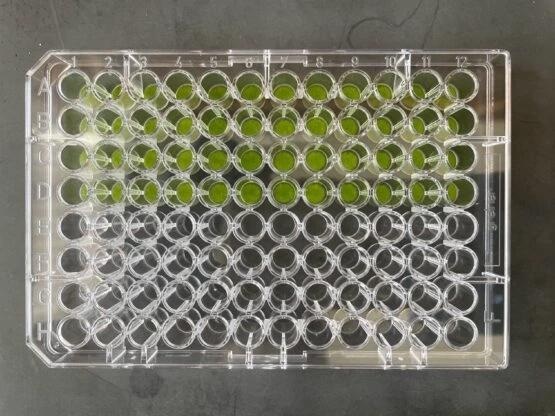Effects of climate change are posing a growing threat to world food production. Crops need to be more adaptable than ever as extreme weather events like floods, droughts, and heat waves grow more frequently.
 The activity of synthetic genetic circuits that process the presence or absence of specific signals in plant leaves was measured in high throughput by placing leaf punches in 96-well plates. When the correct combinations of inputs are delivered to leaves, they fluoresce green, and the fluorescence can be measured using a plate reader. Image Credit: Jennifer Brophy.
The activity of synthetic genetic circuits that process the presence or absence of specific signals in plant leaves was measured in high throughput by placing leaf punches in 96-well plates. When the correct combinations of inputs are delivered to leaves, they fluoresce green, and the fluorescence can be measured using a plate reader. Image Credit: Jennifer Brophy.
Researchers at Stanford University are exploring techniques to influence a plant’s biological processes to improve the effectiveness and efficiency of its growth under various environmental conditions. A number of synthetic genetic circuits have been created by bioengineering assistant professor Jennifer Brophy and her colleagues to influence the choices made by various plant cell types.
The researchers grew plants with altered root systems using these tools. Their work serves as a foundation for developing, testing, and upgrading synthetic genetic circuits for additional applications in plants and is the first step in creating crops that are better able to draw water and nutrients from the soil.
The study was published in the journal Science.
Our synthetic genetic circuits are going to allow us to build very specific root systems or very specific leaf structures to see what is optimal for the challenging environmental conditions that we know are coming. We’re making the engineering of plants much more precise.”
Jennifer Brophy, Assistant Professor, Bioengineering, Stanford University
A programming code for plants
The majority of the genes required, for example, to resist herbicides or pests, are expressed in all of the cells of the genetically modified crop varieties currently in use. Brophy and her coworkers created synthetic DNA that functions much like computer code, with logic gates directing the decision-making process, to gain fine-scale control over plant activity.
In this instance, they were able to modify the number of branches in the root system without affecting the rest of the plant by using those logic gates to designate the cell types that were expressing particular genes.
The efficiency with which a plant extracts various resources from the soil depends on the depth and shape of its root system. A deeper root system that branches at the bottom is better at gathering water and nitrogen, but a shallow root system with many branches is better at absorbing phosphorus (which stays near the surface).
To develop the most productive crops under varied conditions, scientists may test and grow various root designs using these synthetic genetic circuits. Or, in the future, they might enable plants to improve themselves.
We have modern varieties of crops that have lost their ability to respond to where soil nutrients are. The same sort of logic gates that control root branching could be used to, say, create a circuit that takes into account both the nitrogen and phosphorus concentrations in the soil, and then generates an output that is optimal for those conditions.”
José Dinneny, Study Lead Author and Associate Professor, Biology, School of Humanities and Sciences, Stanford University
From model organisms to modern crops
To control gene expression in plants, Brophy created more than 1,000 possible circuits. She experimented with them in tobacco plant leaves to see if she could induce the leaf cells to produce a glow-in-the-dark protein that is present in jellyfish. She discovered 188 designs that were successful, which the researchers are now adding to a database of synthetic DNA so that other researchers can utilize them in their studies.
Once the designs were functional, the scientists utilized one of the circuits to build logic gates that would alter the expression of a particular developmental gene in a particular kind of root cell of Arabidopsis thaliana, a small, weedy plant that is frequently used as a model organism. They were able to alter the density of branches in the root system by altering the expression level of just one gene.
The researchers want to use the same tools on commercial crops now that they have shown they can alter the growth structure of a model organism. They are looking at the possibilities of modifying the root structure of sorghum, a plant that can be converted into biofuel, to improve water absorption and photosynthesis.
Climate change is altering the agricultural conditions in which we grow the plants that we rely on for food, fuels, fibers, and raw materials for medicines. If we’re not able to produce those plants at scale, we’re going to be facing a lot of problems. This work is to help ensure that we will have plant varieties that we can grow, even if the environmental conditions that we’re growing them in become less favorable.”
Jennifer Brophy, Assistant Professor, Bioengineering, Stanford University
Source:
Journal reference:
Brophy, J. A. N., et al. (2022) Synthetic genetic circuits as a means of reprogramming plant roots. Science. doi.org/10.1126/science.abo4326.